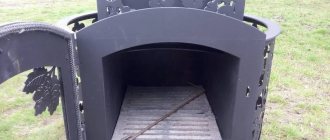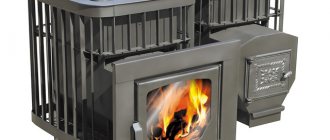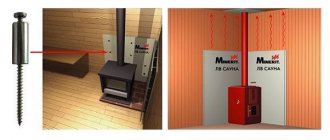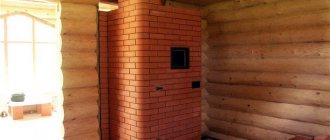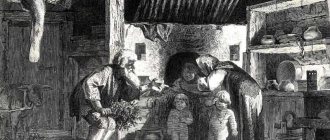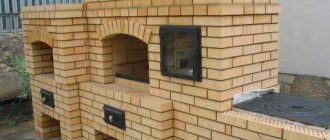Construction of gas burners
There are two types of similar products:
- The first is called atmospheric.
Such devices operate by absorbing air and at the same time have a simple design.
The nozzles do not require automation or various additional devices; it is only sufficient to ensure good air circulation in the room where the stove is located.
The design of such a device may also include detectors to measure oxygen levels to prevent dangerous situations caused by low oxygen levels.
It is believed that atmospheric devices have a relatively low power , but it is quite sufficient for heating medium-sized rooms. You can also note the simplicity of the design of such units, their noiselessness and compactness.
- In turn, supercharged or blowing devices have a more complex design. The basis of the operation of such devices is the forced supply of air into the oven chamber to form a mixture on the basis of which the oven operates. Due to this mechanism, the correct ratios in the mixture are achieved.
Photo 1. A gas forced-air burner provides forced air supply into the furnace chamber, where a mixture for work is formed.
The devices are safe , since the processes take place in a confined space. They also have high efficiency rates and are more environmentally friendly devices than atmospheric burners.
Reference! If we are talking about atmospheric units, then the boilers will have open combustion chambers. In forced-air boilers, boilers have closed chambers.
Equipment setup
Floor-standing gas boilers with an atmospheric burner can be configured independently. Pressurized systems are regulated by an automatic control unit and do not require additional configuration.
Scheme of actions for setting up single-stage equipment:
- Install the device on the boiler.
- Connect to the gas pipe.
- Check for absolute tightness.
- Remove the burner housing.
- Using a pressure gauge, measure the gas pressure at the inlet.
- Connect to electricity. Make sure that the jumpers and phases are connected correctly.
- Place a gas analyzer in the chimney pipe.
- Start the device.
- Using a pressure gauge, take pressure readings at the outlet of the burner block. Pressure readings must correspond to the parameters indicated in the data sheet.
- Adjust the air flow using the air damper.
- The gas analyzer readings must also comply with all gas equipment installation standards.
Setting up gas equipment should be carried out by specialists. The simplest open-type boilers can be configured independently if you have certain skills and knowledge of the design of the burner unit. The efficiency of the boiler, its level of efficiency, and fuel consumption depend on the quality of the burner. It is possible to superficially determine that the equipment is malfunctioning by the changed burner flame.
A heating system where the main element is a gas stove is a common type of heating for private households and cottages. There are many things in favor of natural gas as a heat source: high efficiency, environmental friendliness, and the ability to make the heating process fully automated. The fuel itself is also the most inexpensive at present, unless, of course, you take into account wind energy and solar radiation. But these methods have not yet found wide demand due to the unaffordable price of the equipment.
The quality of gas heating depends on how efficiently the gas burner for the stove works.
How to choose a good device?
The main characteristics of such products are:
When choosing a device, you need to keep the following factors in mind:
- Simplicity of design. In this case, the cross-sections of the paths for the passage of gas must be the same and create minimal resistance to the gas.
- Room size. For small rooms, an atmospheric device will be sufficient, but for larger rooms the power of such devices may not be enough.
- Manufacturer of the product. Domestic and foreign (mostly products made in Germany are on the market) units have approximately the same cost, but some similar devices are designed for installation in specific types of stoves. For example, the domestic product AGG-15 is suitable for use only in stoves with a long channel for the fuel mixture.
Photo 2. Gas nozzle AGG-26, suitable for furnaces with a long channel.
- Type of heating device.
Important! You need to know where the fuel will come from to the heating device: from individual cylinders or from the main pipe. This is also taken into account when installing the stove.
Making a nozzle with your own hands
Before you start using a product made at home with your own hands, you need to go through the following procedures:
- The burner must undergo a quality check at the local Rostechnadzor office in accordance with the regulations established in the Federal Law on the Safety of Buildings and Structures dated December 30, 2009.
- After this check, it is necessary to obtain a certificate from Rostekhnadzor regarding the suitability of the burner for operation.
In order to start making the nozzle, you need the following materials:
- A valve that will serve to regulate the fuel supply of the device. To supply gas to the burner, you must use the valve installed on the gas source.
- Steel pipe. It is desirable that it have a thickness of up to 2 mm and a length of up to 100 mm.
- Steel cap for making a fuel dispenser. You can also use a jet from a blowtorch.
- Steel handle. It can be made from a regular fitting.
- Rubber for handle lining.
- Wire. It will be used for welding.
You will also need the following tools:
- Welding machine.
- Grinder for cutting parts.
For homemade production, an atmospheric nozzle is preferable due to the simplicity of its design. The procedure is as follows:
- First, screw the cap onto the valve. For example, if a standard VK-74 valve is used, then the cap has a conical thread.
- Then, by cutting the existing steel pipe with a grinder to the required size, the nozzle of the future nozzle is made - its basis.
- Next, the nozzle is welded to the cap using wire. In this case, the cap and nozzle should not touch.
- A piezoelectric element is installed , which is needed to activate the device.
After this, the product is ready for installation.
Attention! To install a system for supplying fuel to the stove from a central heating system, you need special equipment and experience working with gas systems.
Furnace installation
When installing a finished unit in a furnace, take into account what materials it is made of:
The gas nozzle - the heart of the stove - must be of high quality and correctly installed. If this unit malfunctions, fuel-related problems may occur, which can lead to irreversible consequences.
Required Permissions and Installation Requirements
To install a burner in a sauna stove, permission from the gas supply authorities is required. In the case of atmospheric devices, operating conditions must meet the following requirements:
- the presence of a high-quality room ventilation system;
- adjustable traction;
- the volume of the premises being used is at least 12 m³;
- ensuring fire safety measures: reliable insulation of the chimney when laying the chimney through the floor slabs and roofing system, equipping the top with a spark arrester.
When purchasing a device, a set of documents is included in the form of certificates of conformity and permission from Rostechnadzor. If the installation rules are followed and the above documentation is available, there is a chance to obtain permission for operation from the gas supply organization.
When installing supercharged models, it is sufficient to comply with fire safety rules and the availability of accompanying documentation, since due to the features of the functionality, there are no requirements for the place of operation.
It is worth considering that all this is valid when using main gas. In the case of autonomous gasification, for storing liquefied gas cylinders, according to the regulations, a separate metal cabinet is used or a gas tank is equipped. The underground tank provides for volumes of 3 m³ and a location at least 5 m from the building. A pipeline of steel pipes is laid from the storage facility to the heat generator, ensuring reliable tightness of the channel.
Types of burners
Many people believe that a burner is simply a nozzle through which gas is supplied. But it is not so. It also mixes air into the fuel. It is important to consider that the product must have a special design that makes the mixture stable.
The device can be of several types, depending on the method of adding oxygen to the gas:
- atmospheric burner;
- ventilator;
- diffusion-kinetic.
Atmospheric
The operating principle of this component is simple: gas passes through an ejector, where its pressure is reduced. In this case, air gets inside due to different atmospheric parameters.
These devices have many advantages:
- simple design;
- compactness;
- quiet operation;
- reasonable cost;
- the possibility of converting a solid fuel boiler for this equipment - the burner is simply installed in the ash pan chamber.
Fan
In this type of device, air is supplied in the required quantity through a fan. Due to this supply of oxygen, they have many advantages:
- There are no restrictions on power - any amount of gas is provided with the required amount of air, which is needed for complete combustion without residues.
- The chamber in which the reaction takes place may be closed. Oxygen enters inside through a special air duct. This allows you to completely prevent combustion products from entering the house due to reverse draft. There is no need to install a separate air duct. For this, special coaxial chimneys are used, which in fact are a pipe located inside another. The smoke is discharged through the internal element, and oxygen enters the boiler, passing between the internal and external walls.
- Human participation during use is minimized, since the equipment has a “smart” configuration function.
This type of burner also has a number of disadvantages:
- Compared to atmospheric ones, they are noticeably louder.
- They have a high price.
- They only work in conjunction with electricity - they must have their own uninterruptible power supply. Otherwise, they may fail due to voltage drop.
Diffusion-kinetic
Basically, such equipment is found in large industrial heaters. The operating principle is based on both atmospheric and fan heating.
DIY gas burner
Since designing a fan type requires special equipment, let’s consider creating a gas burner for a solid fuel boiler with your own hands. It is best to choose a valve from an oxygen cylinder, standard VK-74. To do this you need:
- The outlet pipe is additionally equipped with a fitting, which can be connected to the reactor using a hose.
- A cap with a small hole for connection to the nozzle is installed on the inlet side of the pipe connected to the cylinder. The latter can be taken from a blowtorch or stove.
- A steel pipe with a length of 100 mm and a wall thickness of 2 mm is welded to the cap.
- It is imperative to ensure that there is a gap of 15 mm between the cap and the nozzle, through which oxygen will flow. That is why you must first attach three small pieces of wire to the first one (they can then be bent to the desired location), and only then the pipe.
- The burner itself is ready. After this, you need to make a base on which it will be located for installation in the combustion chamber.
In addition to creating the burner itself, it is also important to follow the process of lighting it:
- The gas supply valve on the cylinder or line opens.
- A match is brought to the nozzle.
- The main valve opens.
Important! The power of the device can be adjusted using a valve. The hottest flame is green-blue.
The whole setup consists of placing the torch in the center. To do this, the wire holders are slightly bent.
Advantages and disadvantages
The use of gas heat generators in a bathhouse has many advantages:
- efficiency. You just need to open the valve and light the nozzle, and in an hour the steam room will be ready. There is no need to prepare and store firewood/coal, load the firebox, or control the work process;
- high efficiency. The performance of gas-powered equipment is significantly higher compared to TT units;
- environmental friendliness. During operation, gas burners for sauna stoves provide a low level of emissions harmful to the environment;
- ease of maintenance and care. There is no need to remove ash, as is the case with solid fuel. All that is required is timely cleaning of the chimney;
- efficiency. This figure is almost 30% higher than that of TT boilers, and more than 100% higher than that of electric heat generators.
The main disadvantage of gas burners for sauna stoves is the need to obtain permits for installation.
Features of use
Gas burners are unpretentious in maintenance. The main feature is annual cleaning. In this case, the procedure should only be carried out by highly qualified specialists, since this requires disassembling the boiler. Most often, burner cleaning is carried out by a service center.
Dirt can be easily removed using compressed air. It is important to set the appropriate pressure. The fact is that some modern parts may not withstand a flow of 10 atm.
To make the cleaning process faster and less frequently required, a special filter is installed on the gas supply. This is done by the master after submitting an application to the appropriate structure.
Well, despite the fact that a gas burner in a heating boiler seems like a very complex engineering unit, you can still make it yourself without any problems. To do this, you need to prepare all the necessary materials and have the skills to work with metal. In addition, you must have several units of special tools.
Internal structure of a gas furnace
A standard gas stove for a bath has the following device: a gas burner is mounted in the body, to which a fuel source is hermetically connected. Depending on the model, there may also be a hot water tank, which can be purchased separately. On top of the body there is a tray for stones and a removal device for combustion products.
The most suitable for a gas sauna stove are round cobblestones from the river or sea bottom. They are considered the most hardened for such extreme conditions, because thanks to the gas they will have to heat up quickly and heat up to 200? C, after which water will also be poured onto them for steam.
Also, all gas sauna stoves must have a housing, a thermostat and a fuse that will automatically stop the gas supply if the fire suddenly goes out. Actually, just under the stones there will be a sealed gas chamber with combustible gas.
Types of gas burners
Before classifying gas burners for boilers, you should determine what is happening inside, and this is:
- passage of flammable material through the burner (in our case gas),
- adding air to this fuel.
The design of the device must maintain combustion stability of the gas-air composition.
There are several types of burners based on the method of supplying air to the gas flow:
- atmospheric;
- with fans;
- diffuse-kinetic.
Also, a homemade gas burner differs in the number of stages:
- One step. First of all, this is the operation of the device with stable power: the temperature of the air in the premises or the thermal fluid is maintained at a certain level. This is the merit of igniting or turning off the burner at the required time. In this case, temperature jumps are observed within a certain spectrum. It is worth noting the rather modest service life of such a burner.
- Two steps. The device operates in two modes. When the load on the heating network is low, half mode operates, ensuring stable operation of the boiler and less wear and tear on the equipment. The nominal mode is activated at heavy loads. The power of the device can be controlled gradually from zero to the nominal value. Therefore, gas equipment can operate continuously and in optimal conditions for many years.
As for the characteristic features of a good burner, these are: the efficiency of the device, nitrogen oxide and carbon monoxide enter the air;
- decent service life of the device;
- simplicity of design;
- ease of installation;
- noise within sanitary standards;
- quick changeover from one type of fuel to another. This criterion applies to combined versions.
Atmospheric gas burners
They suck in air like a jet pump. That is, the gas follows through the ejector, where due to high dynamics its pressure decreases. Air is introduced into the gas flow due to pressure surges.
- simple design;
- compact dimensions;
- energy independence;
- low noise;
- attractive prices.
With such a burner, a boiler operating on solid fuel can be converted to operate on gas. To do this, you need to install the burner in the ash pan section.
Fan gas burners
In them, a fan is responsible for pumping air. Air is introduced in the required volumes. Oxygen is supplied forcibly. That's why:
- There are no power restrictions. Thanks to the fan, various volumes of gas fuel can be supplied with the necessary amount of air to ensure complete combustion.
- The combustion department (gas) can be isolated from the boiler room. Air enters it from the outside - through a special air duct. This reduces the threat of gases from smoke entering the house.
In atmospheric analogues, a closed compartment is not possible. Reason: natural draft cannot cope with the air resistance in the air duct and provide the burner with the required volumes of air.
A boiler with a closed gas chamber can operate without installing a separate air duct. This is due to the use of coaxial chimneys. They have an internal pipe to eliminate flue gases. There is a cylindrical tunnel to allow new air to enter. It is located between the outer and inner pipe.
Versions with forced air injection can be adjusted independently. They require minimal user input.
Disadvantages of fan gas burners:
- high prices;
- powerful noises during operation;
- dependence on electricity - they need sources of stable power.
Diffusion-kinetic burners
They are usually found in high-power industrial heating units. They combine the basics of the previous two types of burners.
Ignition type
All burners can be divided according to the type of ignition:
- Electronic type . They do not have a constantly working igniter. Requires electricity to operate. Electric ignition is one of the most convenient inventions for modern heating units. Thanks to him, the operation of the stoves has become as comfortable as possible. Electric ignition makes it possible to light the burner flame safely, without using available wicks or lighters.
- Burners with piezo ignition . No electricity needed.
Sometimes special working conditions are required, for example, burners are placed in a sauna stove, which must distribute the flame well. These are dividers or ordinary distribution tubes. This is how kitchen gas ovens work.
The fuel consumption passing through the burner can vary widely and depend on its design.
Gas burners for your furnace should be safe and energy efficient. This can be achieved if all technical requirements are met. Self-indulgence in this matter can only do harm. Therefore, the installation of gas burners must be carried out by specialists.
source
Converting a brick or metal stove to gas processing is a difficult process that requires a serious analysis of all components. It is imperative to find out which types of gas burners are ideal for furnaces and which ones should not be installed. After all, the result must meet exactly your requirements.
It would seem that the choice of model can be entrusted to gas workers; they can also be entrusted with reworking the burner block and installing the burner itself. But where is the guarantee that the equipment that you will be offered to install will have the necessary operating parameters and desired functionality?
In this article we will tell you how to independently understand the types of gas burners, the basic rules for their installation and operation, so that you can consciously choose which device to install in your heating stove.
The process of creating a burner yourself
A homemade version of the burner for gas boilers operating on solid fuel can be made based on a valve from a gas cylinder, more precisely an oxygen one. A homemade fitting must be inserted into its outlet pipe. It can then be attached to the gearbox. The connecting element becomes a rubber-fabric hose when manufactured independently.
The inlet pipe enters the cylinder itself during the manufacturing process. You need to put a cap on it. A hole is made in the cap for connecting a jet, which is taken from a gas stove or a blowtorch.
Using welding, a nozzle is attached to a homemade cap. The nozzle is a steel pipe element. Its length is 10 cm. Wall density is 2 mm.
The cap and the nozzle separate some space - 1.5 cm. Air is drawn in through it. For this reason, three thick wire elements are first attached to the cap in the same way. And a pipe-nozzle is mounted to them.
The methods for igniting this homemade product are as follows: opening a tap on the main gas network, or on a cylinder (it is needed when using a liquefied gas format).
The nozzle holds a fire source: a match, a lighter or a lit paper wick. Production is not difficult, at first glance.
DIY options
Often, a homemade gas heating unit is made from an old empty cylinder, which is first filled with water to remove any remaining fuel. To assemble a metal heat generator with your own hands, use ready-made drawings.
Materials and tools:
- empty gas cylinder. You can buy a new cylinder or find a used one at a scrap metal collection point;
- used wheels from trucks and cars, they are selected depending on the expected power of gas-fuel heating equipment;
- metal pipes. For supplying gas and air, a model with a cross-section of 2 cm is used; a pipe with a diameter of 4 cm is suitable for constructing a chimney;
- atmospheric burner;
- Bulgarian;
- drill with appropriate attachments;
- welding machine.
Sequence of work:
- Using a grinder, cut a hole in the upper part of the cylinder to fit the dimensions of the wheel rim.
- The disk is inserted into the hole and welded using a welding machine.
- The air supply structure is made from a pipe d2 cm by drilling 9-11 holes with a diameter of 5 mm on the surface.
- A hole d50 mm is drilled in the lower part of the cylinder, a pipe is inserted so that on one side it protrudes 15-20 cm. The seams are sealed by welding.
- The gas pipe is welded in a similar way, the free end is equipped with an adapter for connection.
- A chimney is installed in the upper part of the structure.
At the end, the firebox door is made from a steel plate, a hole is cut out from the side of the homemade structure for it and installed on the hinges.
Hand-drawn diagram of a homemade gas burner for a sauna stove
Service details
Maintenance of gas burners of any homemade version involves only cleaning it. This process must be annual. Doing it yourself is not recommended. After all, you will have to disassemble and reassemble the boiler. As a rule, people turn to service centers for service. Accumulated contaminants are eliminated by air blowing. The air here is compressed.
The pressure to the burners must be adjusted carefully. For example, for some current versions of burners, parameters of 8-10 atm can be detrimental.
The need for cleaning the burner can be reduced significantly if a filter is installed on the gas supply pipe. This work is performed by a gas service employee, who should be contacted with a special request.
Is it possible to make a gas burner for a boiler with your own hands? Questions and answers
Modification of heating equipment, or simply put, its improvement, is necessary to improve operating efficiency. Servicing solid fuel boilers and constantly monitoring the level of firewood or coal in the firebox sometimes pushes owners to solve non-standard problems. If it becomes possible to connect the house to the gas main, but there is no desire to buy a new special boiler, they begin to come up with homemade devices for heating water in the heat exchanger of heating equipment.
It is necessary to immediately make a reservation that any handicraft products intended for heating systems must undergo a number of checks, namely:
- Obtaining a quality certificate.
- Permits from the State Technical Supervision Authority.
- Checking the design for compliance with quality and operational parameters.



